Comprehensive Analysis of Toyota's Marketing and Consumer Behavior
VerifiedAdded on 2023/01/04
|12
|3122
|95
Report
AI Summary
This report provides a comprehensive analysis of Toyota's marketing strategies and consumer behavior within the automobile industry. It begins with an introduction to Toyota and its market position, followed by an examination of the consumer decision-making process, highlighting the stages involved in purchasing a vehicle. The report then applies Porter's Five Forces model to assess the competitive landscape of the automotive industry and analyze Toyota's position within it. Further analysis includes the application of GE and BCG matrices to evaluate Toyota's strategic business units. Finally, the report explores Toyota's segmentation, targeting, and positioning strategies, revealing how the company caters to diverse consumer segments and maintains its market presence.
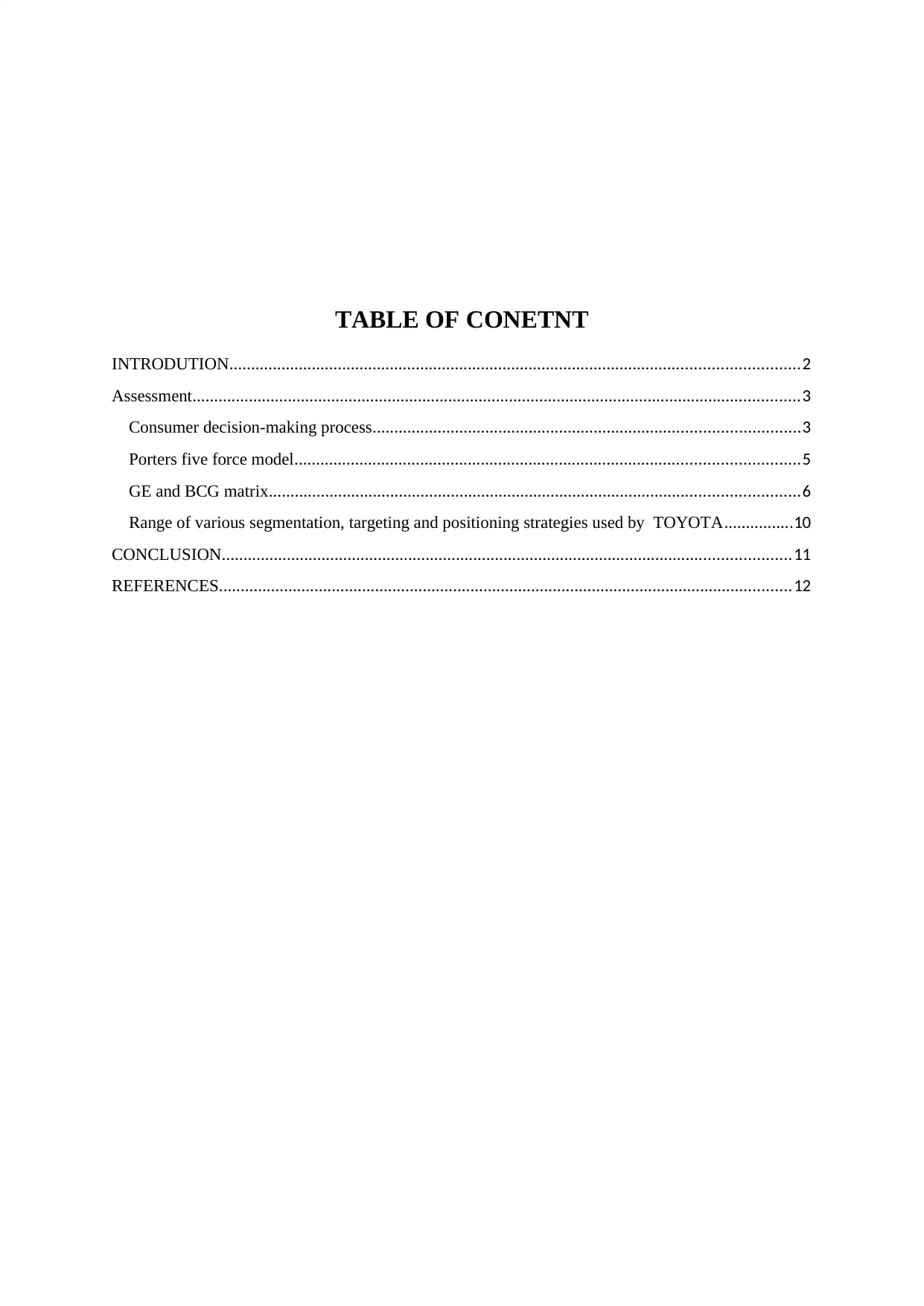
TABLE OF CONETNT
INTRODUTION...................................................................................................................................2
Assessment............................................................................................................................................3
Consumer decision-making process..................................................................................................3
Porters five force model....................................................................................................................5
GE and BCG matrix..........................................................................................................................6
Range of various segmentation, targeting and positioning strategies used by TOYOTA................10
CONCLUSION...................................................................................................................................11
REFERENCES....................................................................................................................................12
INTRODUTION...................................................................................................................................2
Assessment............................................................................................................................................3
Consumer decision-making process..................................................................................................3
Porters five force model....................................................................................................................5
GE and BCG matrix..........................................................................................................................6
Range of various segmentation, targeting and positioning strategies used by TOYOTA................10
CONCLUSION...................................................................................................................................11
REFERENCES....................................................................................................................................12
Paraphrase This Document
Need a fresh take? Get an instant paraphrase of this document with our AI Paraphraser
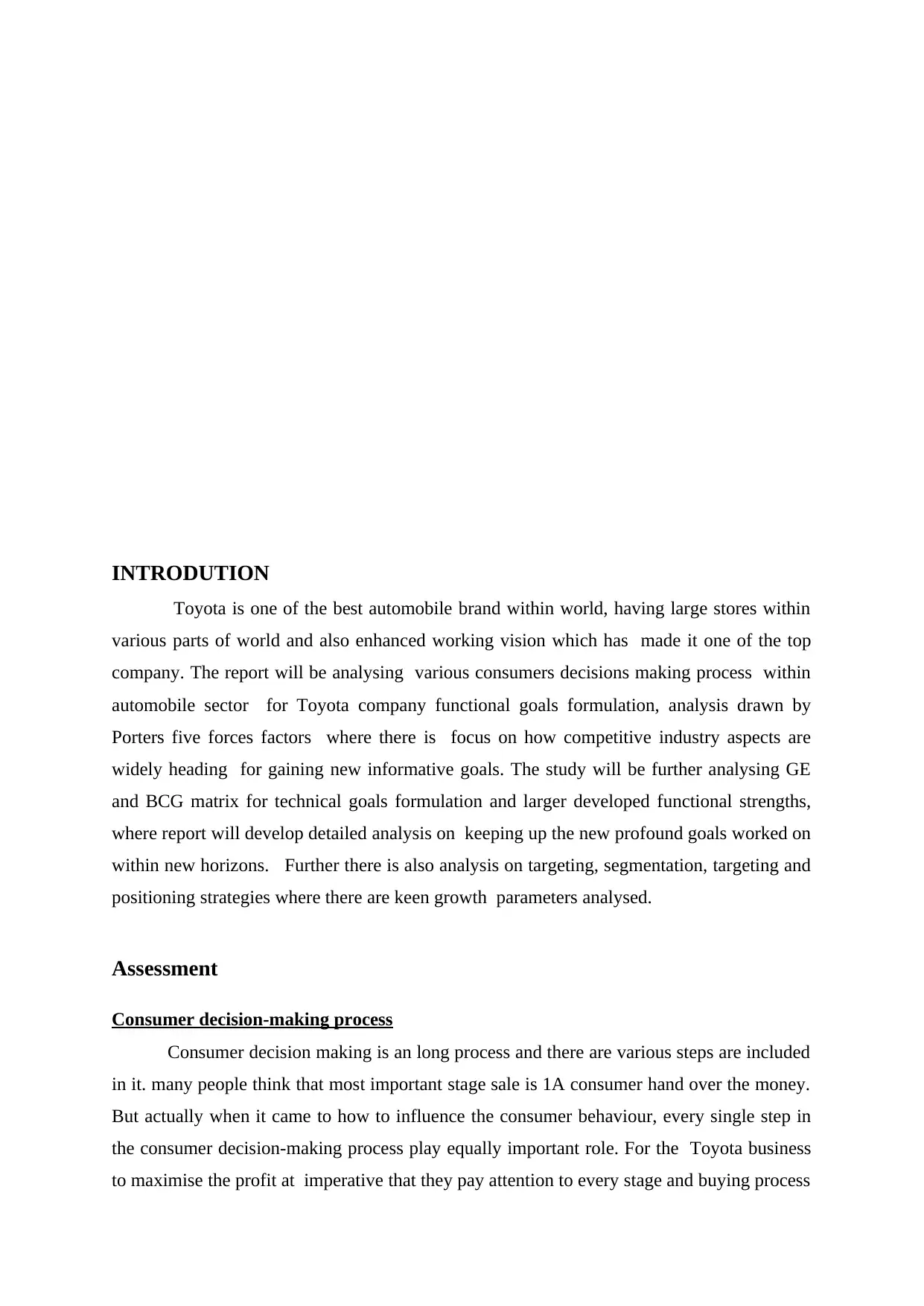
INTRODUTION
Toyota is one of the best automobile brand within world, having large stores within
various parts of world and also enhanced working vision which has made it one of the top
company. The report will be analysing various consumers decisions making process within
automobile sector for Toyota company functional goals formulation, analysis drawn by
Porters five forces factors where there is focus on how competitive industry aspects are
widely heading for gaining new informative goals. The study will be further analysing GE
and BCG matrix for technical goals formulation and larger developed functional strengths,
where report will develop detailed analysis on keeping up the new profound goals worked on
within new horizons. Further there is also analysis on targeting, segmentation, targeting and
positioning strategies where there are keen growth parameters analysed.
Assessment
Consumer decision-making process
Consumer decision making is an long process and there are various steps are included
in it. many people think that most important stage sale is 1A consumer hand over the money.
But actually when it came to how to influence the consumer behaviour, every single step in
the consumer decision-making process play equally important role. For the Toyota business
to maximise the profit at imperative that they pay attention to every stage and buying process
Toyota is one of the best automobile brand within world, having large stores within
various parts of world and also enhanced working vision which has made it one of the top
company. The report will be analysing various consumers decisions making process within
automobile sector for Toyota company functional goals formulation, analysis drawn by
Porters five forces factors where there is focus on how competitive industry aspects are
widely heading for gaining new informative goals. The study will be further analysing GE
and BCG matrix for technical goals formulation and larger developed functional strengths,
where report will develop detailed analysis on keeping up the new profound goals worked on
within new horizons. Further there is also analysis on targeting, segmentation, targeting and
positioning strategies where there are keen growth parameters analysed.
Assessment
Consumer decision-making process
Consumer decision making is an long process and there are various steps are included
in it. many people think that most important stage sale is 1A consumer hand over the money.
But actually when it came to how to influence the consumer behaviour, every single step in
the consumer decision-making process play equally important role. For the Toyota business
to maximise the profit at imperative that they pay attention to every stage and buying process
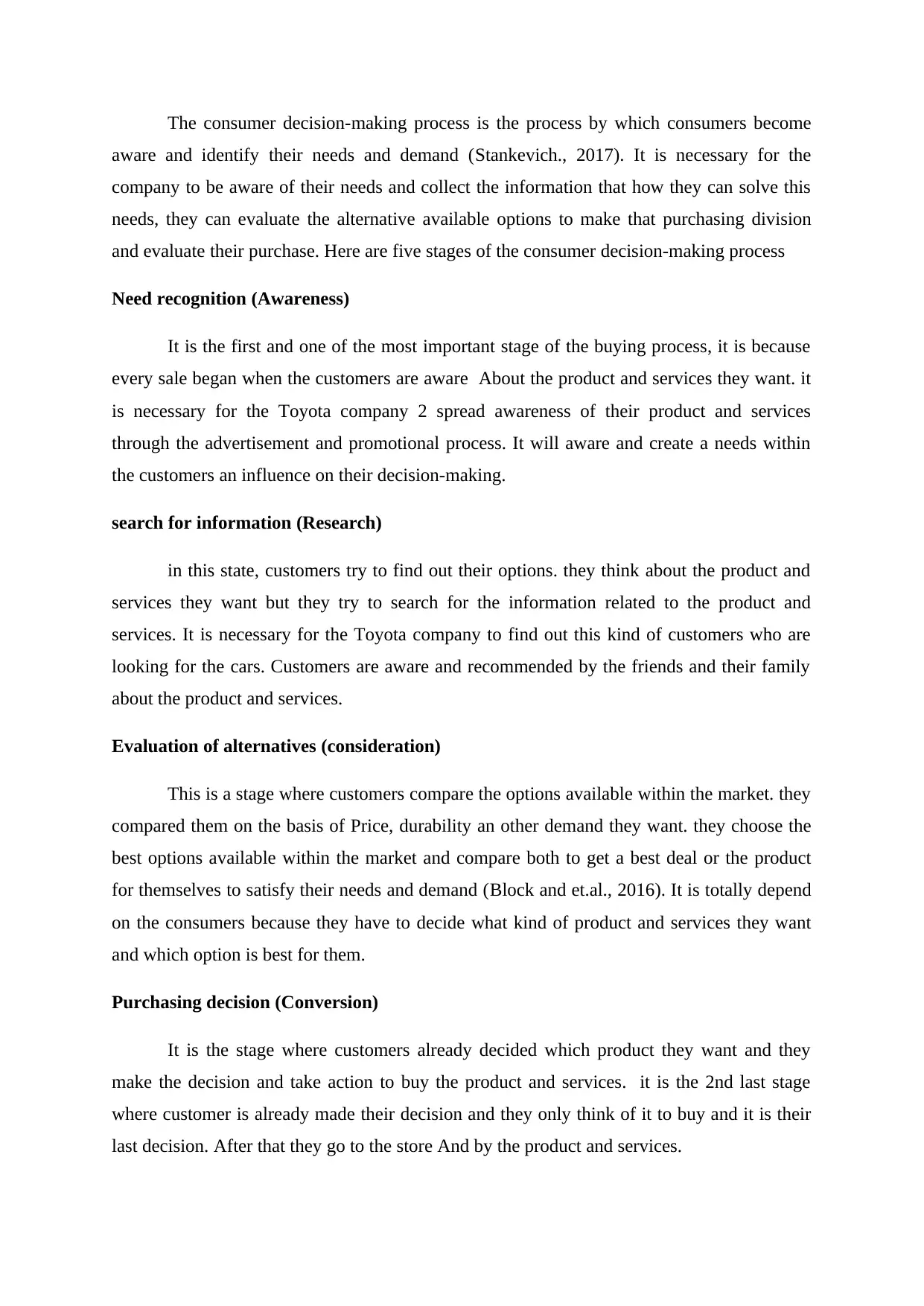
The consumer decision-making process is the process by which consumers become
aware and identify their needs and demand (Stankevich., 2017). It is necessary for the
company to be aware of their needs and collect the information that how they can solve this
needs, they can evaluate the alternative available options to make that purchasing division
and evaluate their purchase. Here are five stages of the consumer decision-making process
Need recognition (Awareness)
It is the first and one of the most important stage of the buying process, it is because
every sale began when the customers are aware About the product and services they want. it
is necessary for the Toyota company 2 spread awareness of their product and services
through the advertisement and promotional process. It will aware and create a needs within
the customers an influence on their decision-making.
search for information (Research)
in this state, customers try to find out their options. they think about the product and
services they want but they try to search for the information related to the product and
services. It is necessary for the Toyota company to find out this kind of customers who are
looking for the cars. Customers are aware and recommended by the friends and their family
about the product and services.
Evaluation of alternatives (consideration)
This is a stage where customers compare the options available within the market. they
compared them on the basis of Price, durability an other demand they want. they choose the
best options available within the market and compare both to get a best deal or the product
for themselves to satisfy their needs and demand (Block and et.al., 2016). It is totally depend
on the consumers because they have to decide what kind of product and services they want
and which option is best for them.
Purchasing decision (Conversion)
It is the stage where customers already decided which product they want and they
make the decision and take action to buy the product and services. it is the 2nd last stage
where customer is already made their decision and they only think of it to buy and it is their
last decision. After that they go to the store And by the product and services.
aware and identify their needs and demand (Stankevich., 2017). It is necessary for the
company to be aware of their needs and collect the information that how they can solve this
needs, they can evaluate the alternative available options to make that purchasing division
and evaluate their purchase. Here are five stages of the consumer decision-making process
Need recognition (Awareness)
It is the first and one of the most important stage of the buying process, it is because
every sale began when the customers are aware About the product and services they want. it
is necessary for the Toyota company 2 spread awareness of their product and services
through the advertisement and promotional process. It will aware and create a needs within
the customers an influence on their decision-making.
search for information (Research)
in this state, customers try to find out their options. they think about the product and
services they want but they try to search for the information related to the product and
services. It is necessary for the Toyota company to find out this kind of customers who are
looking for the cars. Customers are aware and recommended by the friends and their family
about the product and services.
Evaluation of alternatives (consideration)
This is a stage where customers compare the options available within the market. they
compared them on the basis of Price, durability an other demand they want. they choose the
best options available within the market and compare both to get a best deal or the product
for themselves to satisfy their needs and demand (Block and et.al., 2016). It is totally depend
on the consumers because they have to decide what kind of product and services they want
and which option is best for them.
Purchasing decision (Conversion)
It is the stage where customers already decided which product they want and they
make the decision and take action to buy the product and services. it is the 2nd last stage
where customer is already made their decision and they only think of it to buy and it is their
last decision. After that they go to the store And by the product and services.
⊘ This is a preview!⊘
Do you want full access?
Subscribe today to unlock all pages.

Trusted by 1+ million students worldwide
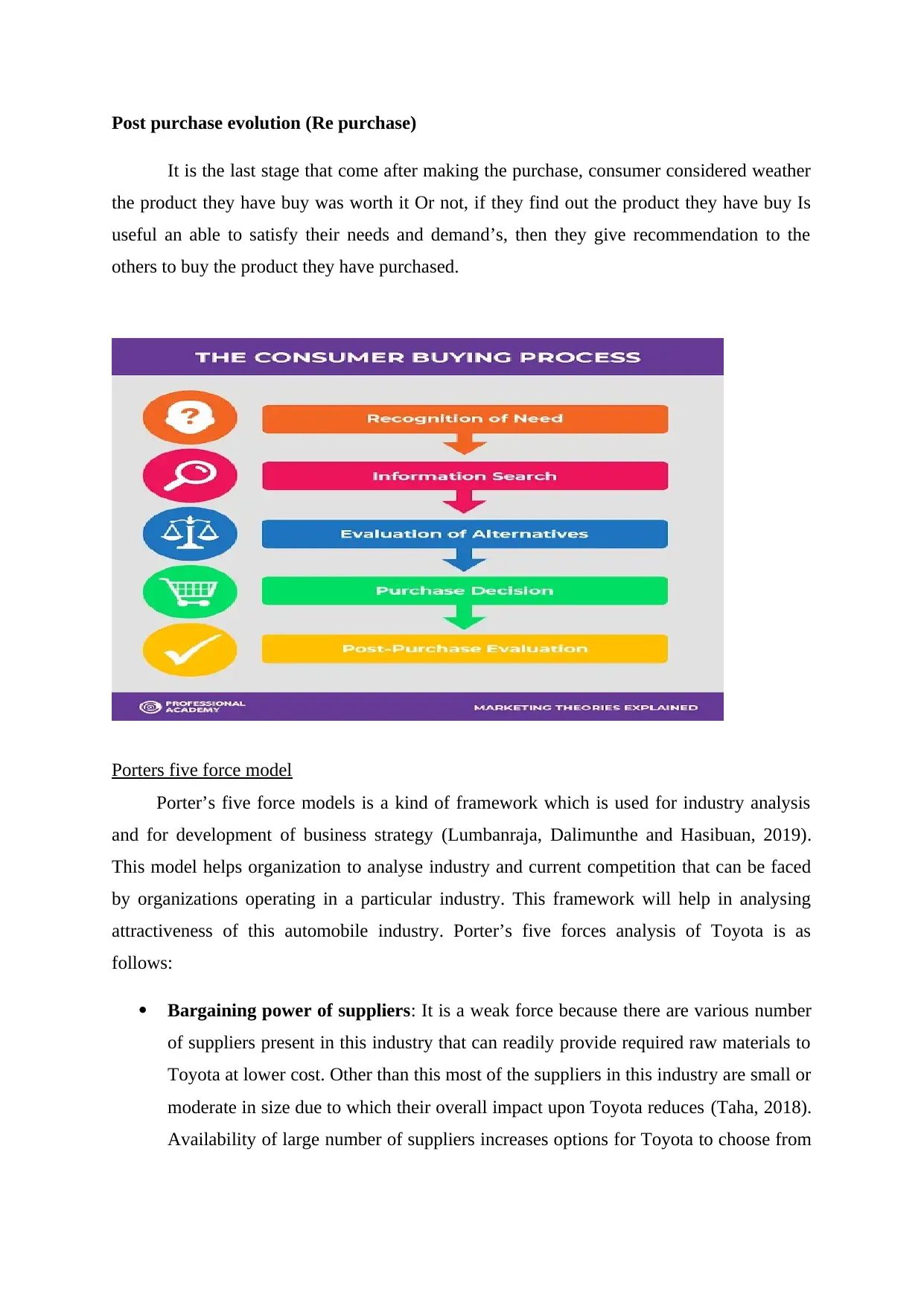
Post purchase evolution (Re purchase)
It is the last stage that come after making the purchase, consumer considered weather
the product they have buy was worth it Or not, if they find out the product they have buy Is
useful an able to satisfy their needs and demand’s, then they give recommendation to the
others to buy the product they have purchased.
Porters five force model
Porter’s five force models is a kind of framework which is used for industry analysis
and for development of business strategy (Lumbanraja, Dalimunthe and Hasibuan, 2019).
This model helps organization to analyse industry and current competition that can be faced
by organizations operating in a particular industry. This framework will help in analysing
attractiveness of this automobile industry. Porter’s five forces analysis of Toyota is as
follows:
Bargaining power of suppliers: It is a weak force because there are various number
of suppliers present in this industry that can readily provide required raw materials to
Toyota at lower cost. Other than this most of the suppliers in this industry are small or
moderate in size due to which their overall impact upon Toyota reduces (Taha, 2018).
Availability of large number of suppliers increases options for Toyota to choose from
It is the last stage that come after making the purchase, consumer considered weather
the product they have buy was worth it Or not, if they find out the product they have buy Is
useful an able to satisfy their needs and demand’s, then they give recommendation to the
others to buy the product they have purchased.
Porters five force model
Porter’s five force models is a kind of framework which is used for industry analysis
and for development of business strategy (Lumbanraja, Dalimunthe and Hasibuan, 2019).
This model helps organization to analyse industry and current competition that can be faced
by organizations operating in a particular industry. This framework will help in analysing
attractiveness of this automobile industry. Porter’s five forces analysis of Toyota is as
follows:
Bargaining power of suppliers: It is a weak force because there are various number
of suppliers present in this industry that can readily provide required raw materials to
Toyota at lower cost. Other than this most of the suppliers in this industry are small or
moderate in size due to which their overall impact upon Toyota reduces (Taha, 2018).
Availability of large number of suppliers increases options for Toyota to choose from
Paraphrase This Document
Need a fresh take? Get an instant paraphrase of this document with our AI Paraphraser
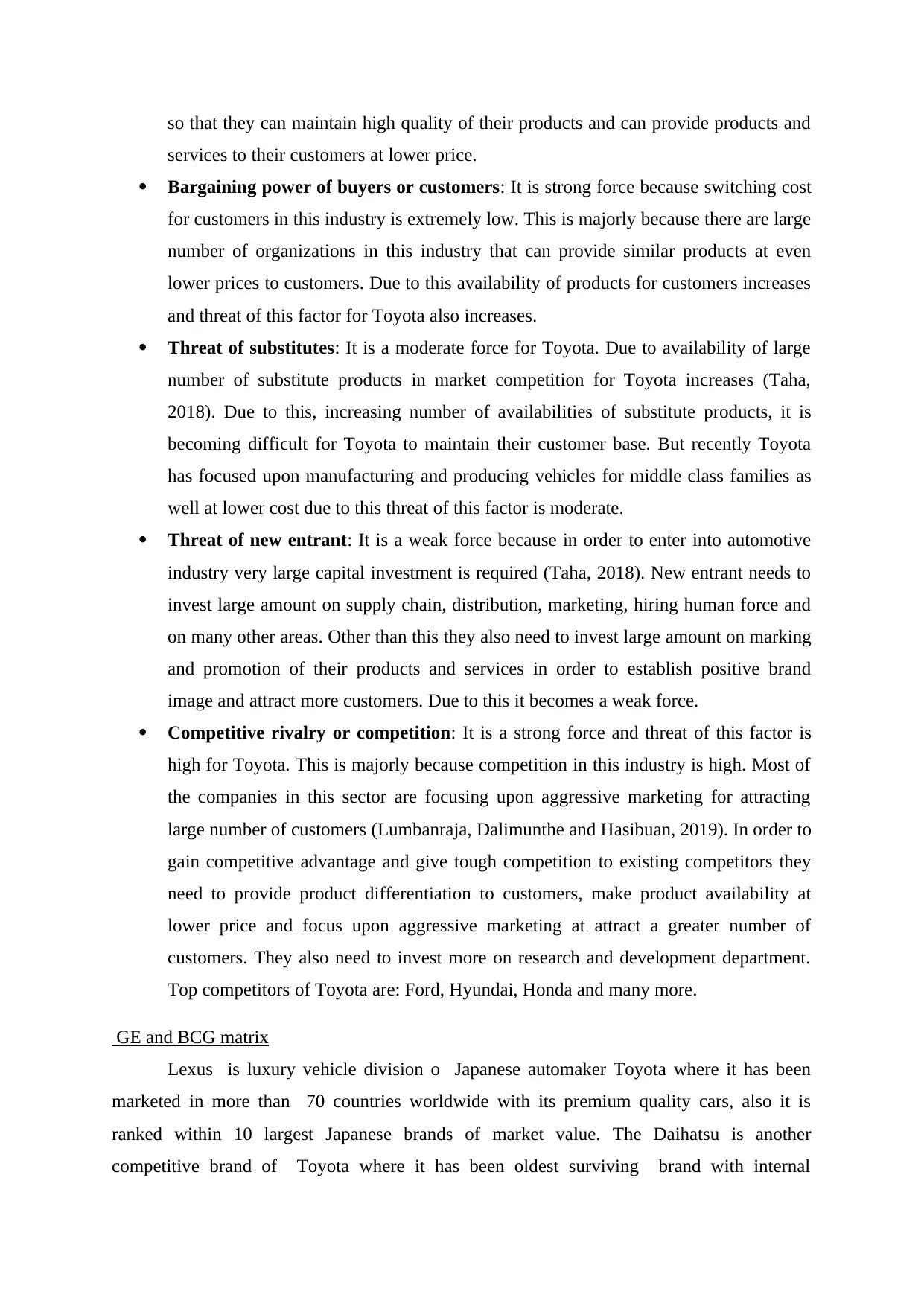
so that they can maintain high quality of their products and can provide products and
services to their customers at lower price.
Bargaining power of buyers or customers: It is strong force because switching cost
for customers in this industry is extremely low. This is majorly because there are large
number of organizations in this industry that can provide similar products at even
lower prices to customers. Due to this availability of products for customers increases
and threat of this factor for Toyota also increases.
Threat of substitutes: It is a moderate force for Toyota. Due to availability of large
number of substitute products in market competition for Toyota increases (Taha,
2018). Due to this, increasing number of availabilities of substitute products, it is
becoming difficult for Toyota to maintain their customer base. But recently Toyota
has focused upon manufacturing and producing vehicles for middle class families as
well at lower cost due to this threat of this factor is moderate.
Threat of new entrant: It is a weak force because in order to enter into automotive
industry very large capital investment is required (Taha, 2018). New entrant needs to
invest large amount on supply chain, distribution, marketing, hiring human force and
on many other areas. Other than this they also need to invest large amount on marking
and promotion of their products and services in order to establish positive brand
image and attract more customers. Due to this it becomes a weak force.
Competitive rivalry or competition: It is a strong force and threat of this factor is
high for Toyota. This is majorly because competition in this industry is high. Most of
the companies in this sector are focusing upon aggressive marketing for attracting
large number of customers (Lumbanraja, Dalimunthe and Hasibuan, 2019). In order to
gain competitive advantage and give tough competition to existing competitors they
need to provide product differentiation to customers, make product availability at
lower price and focus upon aggressive marketing at attract a greater number of
customers. They also need to invest more on research and development department.
Top competitors of Toyota are: Ford, Hyundai, Honda and many more.
GE and BCG matrix
Lexus is luxury vehicle division o Japanese automaker Toyota where it has been
marketed in more than 70 countries worldwide with its premium quality cars, also it is
ranked within 10 largest Japanese brands of market value. The Daihatsu is another
competitive brand of Toyota where it has been oldest surviving brand with internal
services to their customers at lower price.
Bargaining power of buyers or customers: It is strong force because switching cost
for customers in this industry is extremely low. This is majorly because there are large
number of organizations in this industry that can provide similar products at even
lower prices to customers. Due to this availability of products for customers increases
and threat of this factor for Toyota also increases.
Threat of substitutes: It is a moderate force for Toyota. Due to availability of large
number of substitute products in market competition for Toyota increases (Taha,
2018). Due to this, increasing number of availabilities of substitute products, it is
becoming difficult for Toyota to maintain their customer base. But recently Toyota
has focused upon manufacturing and producing vehicles for middle class families as
well at lower cost due to this threat of this factor is moderate.
Threat of new entrant: It is a weak force because in order to enter into automotive
industry very large capital investment is required (Taha, 2018). New entrant needs to
invest large amount on supply chain, distribution, marketing, hiring human force and
on many other areas. Other than this they also need to invest large amount on marking
and promotion of their products and services in order to establish positive brand
image and attract more customers. Due to this it becomes a weak force.
Competitive rivalry or competition: It is a strong force and threat of this factor is
high for Toyota. This is majorly because competition in this industry is high. Most of
the companies in this sector are focusing upon aggressive marketing for attracting
large number of customers (Lumbanraja, Dalimunthe and Hasibuan, 2019). In order to
gain competitive advantage and give tough competition to existing competitors they
need to provide product differentiation to customers, make product availability at
lower price and focus upon aggressive marketing at attract a greater number of
customers. They also need to invest more on research and development department.
Top competitors of Toyota are: Ford, Hyundai, Honda and many more.
GE and BCG matrix
Lexus is luxury vehicle division o Japanese automaker Toyota where it has been
marketed in more than 70 countries worldwide with its premium quality cars, also it is
ranked within 10 largest Japanese brands of market value. The Daihatsu is another
competitive brand of Toyota where it has been oldest surviving brand with internal
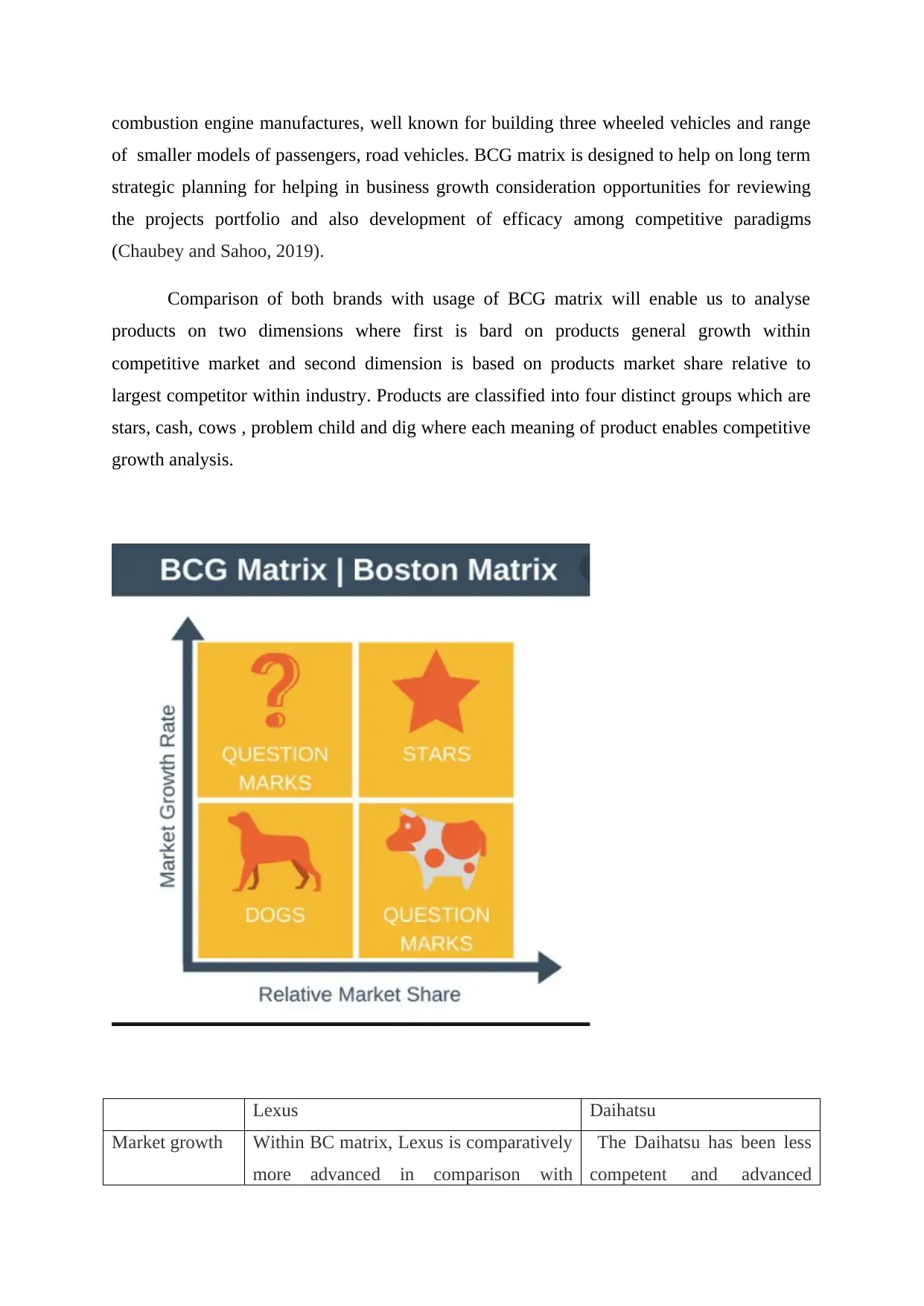
combustion engine manufactures, well known for building three wheeled vehicles and range
of smaller models of passengers, road vehicles. BCG matrix is designed to help on long term
strategic planning for helping in business growth consideration opportunities for reviewing
the projects portfolio and also development of efficacy among competitive paradigms
(Chaubey and Sahoo, 2019).
Comparison of both brands with usage of BCG matrix will enable us to analyse
products on two dimensions where first is bard on products general growth within
competitive market and second dimension is based on products market share relative to
largest competitor within industry. Products are classified into four distinct groups which are
stars, cash, cows , problem child and dig where each meaning of product enables competitive
growth analysis.
Lexus Daihatsu
Market growth Within BC matrix, Lexus is comparatively
more advanced in comparison with
The Daihatsu has been less
competent and advanced
of smaller models of passengers, road vehicles. BCG matrix is designed to help on long term
strategic planning for helping in business growth consideration opportunities for reviewing
the projects portfolio and also development of efficacy among competitive paradigms
(Chaubey and Sahoo, 2019).
Comparison of both brands with usage of BCG matrix will enable us to analyse
products on two dimensions where first is bard on products general growth within
competitive market and second dimension is based on products market share relative to
largest competitor within industry. Products are classified into four distinct groups which are
stars, cash, cows , problem child and dig where each meaning of product enables competitive
growth analysis.
Lexus Daihatsu
Market growth Within BC matrix, Lexus is comparatively
more advanced in comparison with
The Daihatsu has been less
competent and advanced
⊘ This is a preview!⊘
Do you want full access?
Subscribe today to unlock all pages.

Trusted by 1+ million students worldwide
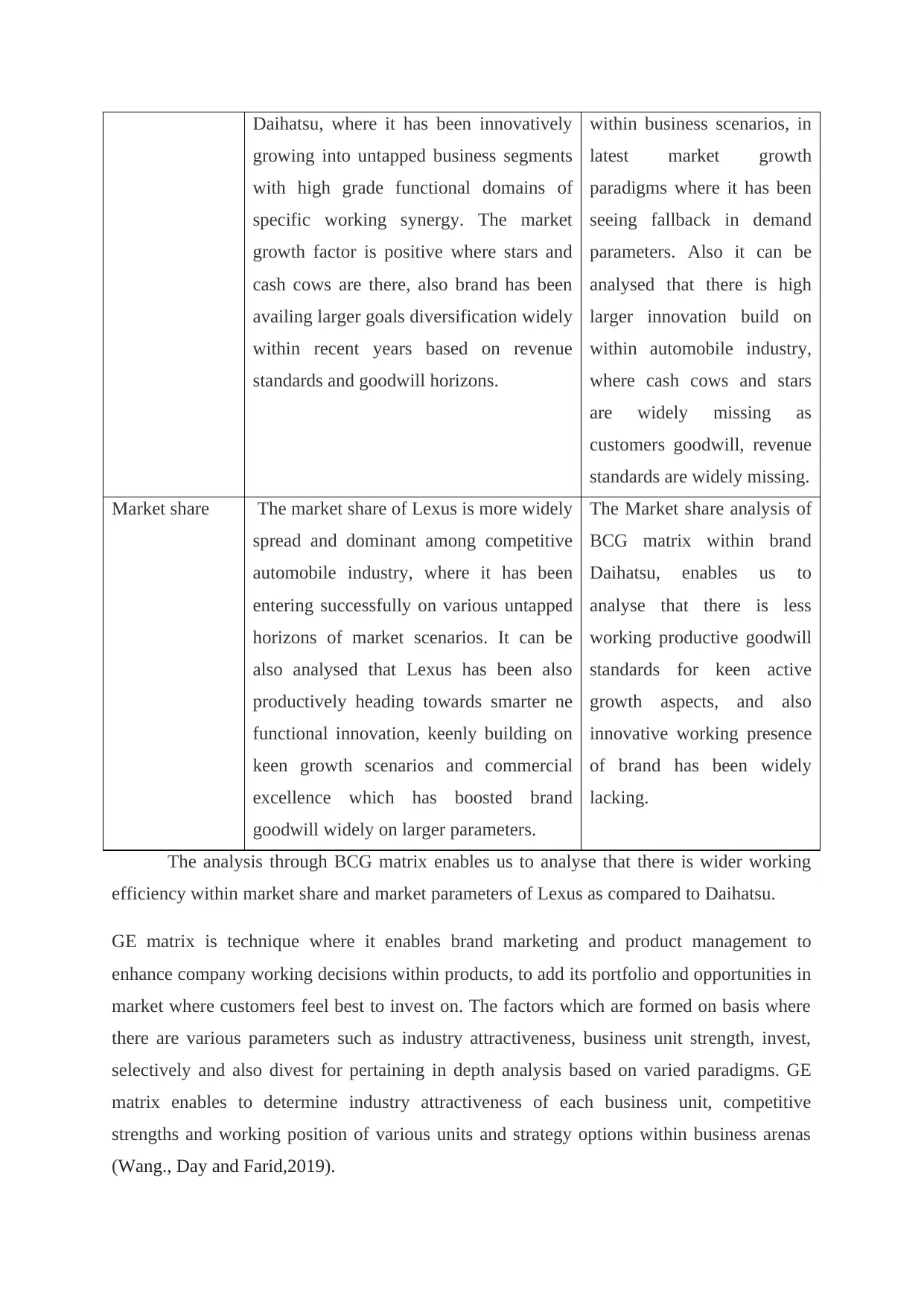
Daihatsu, where it has been innovatively
growing into untapped business segments
with high grade functional domains of
specific working synergy. The market
growth factor is positive where stars and
cash cows are there, also brand has been
availing larger goals diversification widely
within recent years based on revenue
standards and goodwill horizons.
within business scenarios, in
latest market growth
paradigms where it has been
seeing fallback in demand
parameters. Also it can be
analysed that there is high
larger innovation build on
within automobile industry,
where cash cows and stars
are widely missing as
customers goodwill, revenue
standards are widely missing.
Market share The market share of Lexus is more widely
spread and dominant among competitive
automobile industry, where it has been
entering successfully on various untapped
horizons of market scenarios. It can be
also analysed that Lexus has been also
productively heading towards smarter ne
functional innovation, keenly building on
keen growth scenarios and commercial
excellence which has boosted brand
goodwill widely on larger parameters.
The Market share analysis of
BCG matrix within brand
Daihatsu, enables us to
analyse that there is less
working productive goodwill
standards for keen active
growth aspects, and also
innovative working presence
of brand has been widely
lacking.
The analysis through BCG matrix enables us to analyse that there is wider working
efficiency within market share and market parameters of Lexus as compared to Daihatsu.
GE matrix is technique where it enables brand marketing and product management to
enhance company working decisions within products, to add its portfolio and opportunities in
market where customers feel best to invest on. The factors which are formed on basis where
there are various parameters such as industry attractiveness, business unit strength, invest,
selectively and also divest for pertaining in depth analysis based on varied paradigms. GE
matrix enables to determine industry attractiveness of each business unit, competitive
strengths and working position of various units and strategy options within business arenas
(Wang., Day and Farid,2019).
growing into untapped business segments
with high grade functional domains of
specific working synergy. The market
growth factor is positive where stars and
cash cows are there, also brand has been
availing larger goals diversification widely
within recent years based on revenue
standards and goodwill horizons.
within business scenarios, in
latest market growth
paradigms where it has been
seeing fallback in demand
parameters. Also it can be
analysed that there is high
larger innovation build on
within automobile industry,
where cash cows and stars
are widely missing as
customers goodwill, revenue
standards are widely missing.
Market share The market share of Lexus is more widely
spread and dominant among competitive
automobile industry, where it has been
entering successfully on various untapped
horizons of market scenarios. It can be
also analysed that Lexus has been also
productively heading towards smarter ne
functional innovation, keenly building on
keen growth scenarios and commercial
excellence which has boosted brand
goodwill widely on larger parameters.
The Market share analysis of
BCG matrix within brand
Daihatsu, enables us to
analyse that there is less
working productive goodwill
standards for keen active
growth aspects, and also
innovative working presence
of brand has been widely
lacking.
The analysis through BCG matrix enables us to analyse that there is wider working
efficiency within market share and market parameters of Lexus as compared to Daihatsu.
GE matrix is technique where it enables brand marketing and product management to
enhance company working decisions within products, to add its portfolio and opportunities in
market where customers feel best to invest on. The factors which are formed on basis where
there are various parameters such as industry attractiveness, business unit strength, invest,
selectively and also divest for pertaining in depth analysis based on varied paradigms. GE
matrix enables to determine industry attractiveness of each business unit, competitive
strengths and working position of various units and strategy options within business arenas
(Wang., Day and Farid,2019).
Paraphrase This Document
Need a fresh take? Get an instant paraphrase of this document with our AI Paraphraser
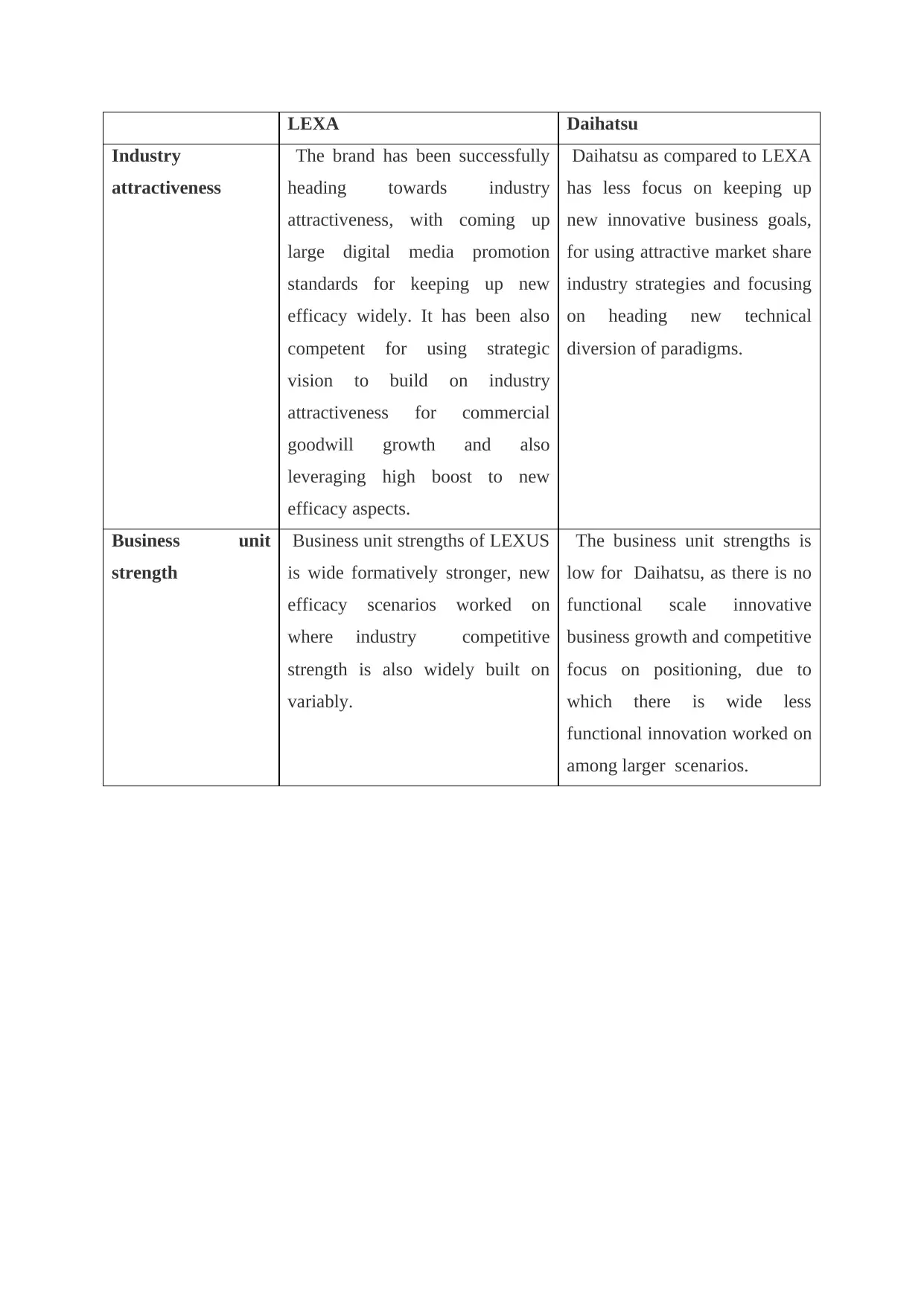
LEXA Daihatsu
Industry
attractiveness
The brand has been successfully
heading towards industry
attractiveness, with coming up
large digital media promotion
standards for keeping up new
efficacy widely. It has been also
competent for using strategic
vision to build on industry
attractiveness for commercial
goodwill growth and also
leveraging high boost to new
efficacy aspects.
Daihatsu as compared to LEXA
has less focus on keeping up
new innovative business goals,
for using attractive market share
industry strategies and focusing
on heading new technical
diversion of paradigms.
Business unit
strength
Business unit strengths of LEXUS
is wide formatively stronger, new
efficacy scenarios worked on
where industry competitive
strength is also widely built on
variably.
The business unit strengths is
low for Daihatsu, as there is no
functional scale innovative
business growth and competitive
focus on positioning, due to
which there is wide less
functional innovation worked on
among larger scenarios.
Industry
attractiveness
The brand has been successfully
heading towards industry
attractiveness, with coming up
large digital media promotion
standards for keeping up new
efficacy widely. It has been also
competent for using strategic
vision to build on industry
attractiveness for commercial
goodwill growth and also
leveraging high boost to new
efficacy aspects.
Daihatsu as compared to LEXA
has less focus on keeping up
new innovative business goals,
for using attractive market share
industry strategies and focusing
on heading new technical
diversion of paradigms.
Business unit
strength
Business unit strengths of LEXUS
is wide formatively stronger, new
efficacy scenarios worked on
where industry competitive
strength is also widely built on
variably.
The business unit strengths is
low for Daihatsu, as there is no
functional scale innovative
business growth and competitive
focus on positioning, due to
which there is wide less
functional innovation worked on
among larger scenarios.
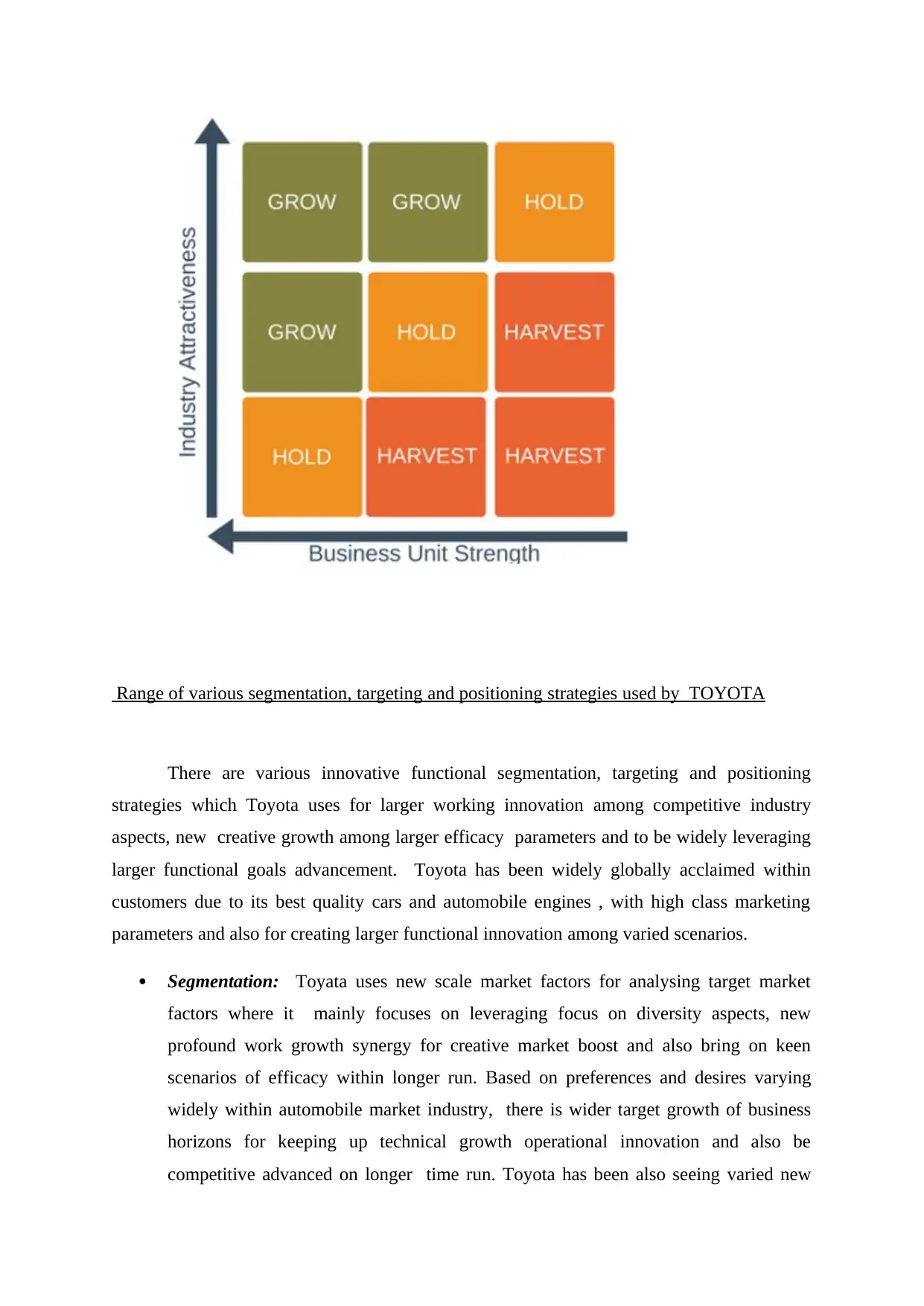
Range of various segmentation, targeting and positioning strategies used by TOYOTA
There are various innovative functional segmentation, targeting and positioning
strategies which Toyota uses for larger working innovation among competitive industry
aspects, new creative growth among larger efficacy parameters and to be widely leveraging
larger functional goals advancement. Toyota has been widely globally acclaimed within
customers due to its best quality cars and automobile engines , with high class marketing
parameters and also for creating larger functional innovation among varied scenarios.
Segmentation: Toyata uses new scale market factors for analysing target market
factors where it mainly focuses on leveraging focus on diversity aspects, new
profound work growth synergy for creative market boost and also bring on keen
scenarios of efficacy within longer run. Based on preferences and desires varying
widely within automobile market industry, there is wider target growth of business
horizons for keeping up technical growth operational innovation and also be
competitive advanced on longer time run. Toyota has been also seeing varied new
There are various innovative functional segmentation, targeting and positioning
strategies which Toyota uses for larger working innovation among competitive industry
aspects, new creative growth among larger efficacy parameters and to be widely leveraging
larger functional goals advancement. Toyota has been widely globally acclaimed within
customers due to its best quality cars and automobile engines , with high class marketing
parameters and also for creating larger functional innovation among varied scenarios.
Segmentation: Toyata uses new scale market factors for analysing target market
factors where it mainly focuses on leveraging focus on diversity aspects, new
profound work growth synergy for creative market boost and also bring on keen
scenarios of efficacy within longer run. Based on preferences and desires varying
widely within automobile market industry, there is wider target growth of business
horizons for keeping up technical growth operational innovation and also be
competitive advanced on longer time run. Toyota has been also seeing varied new
⊘ This is a preview!⊘
Do you want full access?
Subscribe today to unlock all pages.

Trusted by 1+ million students worldwide
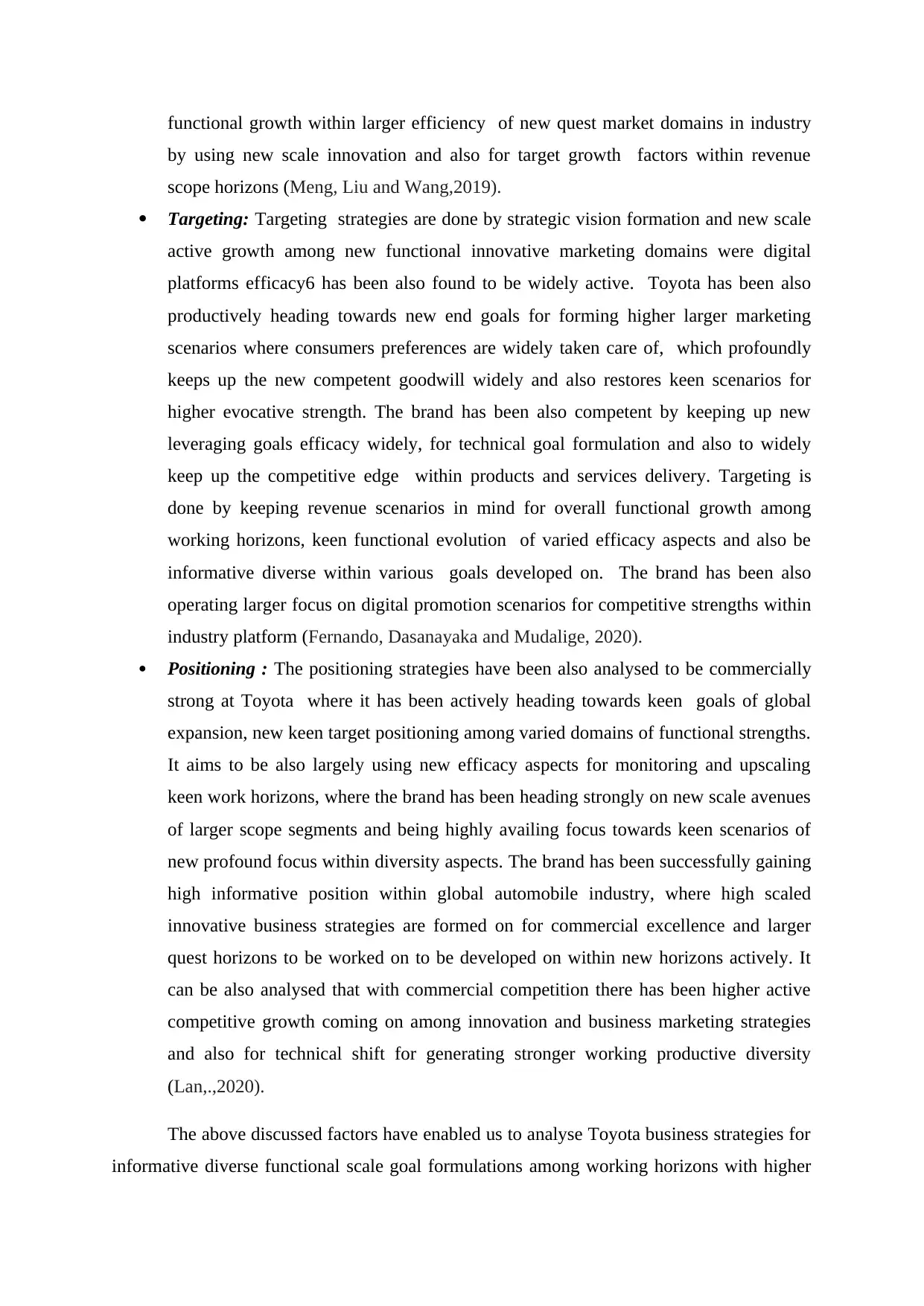
functional growth within larger efficiency of new quest market domains in industry
by using new scale innovation and also for target growth factors within revenue
scope horizons (Meng, Liu and Wang,2019).
Targeting: Targeting strategies are done by strategic vision formation and new scale
active growth among new functional innovative marketing domains were digital
platforms efficacy6 has been also found to be widely active. Toyota has been also
productively heading towards new end goals for forming higher larger marketing
scenarios where consumers preferences are widely taken care of, which profoundly
keeps up the new competent goodwill widely and also restores keen scenarios for
higher evocative strength. The brand has been also competent by keeping up new
leveraging goals efficacy widely, for technical goal formulation and also to widely
keep up the competitive edge within products and services delivery. Targeting is
done by keeping revenue scenarios in mind for overall functional growth among
working horizons, keen functional evolution of varied efficacy aspects and also be
informative diverse within various goals developed on. The brand has been also
operating larger focus on digital promotion scenarios for competitive strengths within
industry platform (Fernando, Dasanayaka and Mudalige, 2020).
Positioning : The positioning strategies have been also analysed to be commercially
strong at Toyota where it has been actively heading towards keen goals of global
expansion, new keen target positioning among varied domains of functional strengths.
It aims to be also largely using new efficacy aspects for monitoring and upscaling
keen work horizons, where the brand has been heading strongly on new scale avenues
of larger scope segments and being highly availing focus towards keen scenarios of
new profound focus within diversity aspects. The brand has been successfully gaining
high informative position within global automobile industry, where high scaled
innovative business strategies are formed on for commercial excellence and larger
quest horizons to be worked on to be developed on within new horizons actively. It
can be also analysed that with commercial competition there has been higher active
competitive growth coming on among innovation and business marketing strategies
and also for technical shift for generating stronger working productive diversity
(Lan,.,2020).
The above discussed factors have enabled us to analyse Toyota business strategies for
informative diverse functional scale goal formulations among working horizons with higher
by using new scale innovation and also for target growth factors within revenue
scope horizons (Meng, Liu and Wang,2019).
Targeting: Targeting strategies are done by strategic vision formation and new scale
active growth among new functional innovative marketing domains were digital
platforms efficacy6 has been also found to be widely active. Toyota has been also
productively heading towards new end goals for forming higher larger marketing
scenarios where consumers preferences are widely taken care of, which profoundly
keeps up the new competent goodwill widely and also restores keen scenarios for
higher evocative strength. The brand has been also competent by keeping up new
leveraging goals efficacy widely, for technical goal formulation and also to widely
keep up the competitive edge within products and services delivery. Targeting is
done by keeping revenue scenarios in mind for overall functional growth among
working horizons, keen functional evolution of varied efficacy aspects and also be
informative diverse within various goals developed on. The brand has been also
operating larger focus on digital promotion scenarios for competitive strengths within
industry platform (Fernando, Dasanayaka and Mudalige, 2020).
Positioning : The positioning strategies have been also analysed to be commercially
strong at Toyota where it has been actively heading towards keen goals of global
expansion, new keen target positioning among varied domains of functional strengths.
It aims to be also largely using new efficacy aspects for monitoring and upscaling
keen work horizons, where the brand has been heading strongly on new scale avenues
of larger scope segments and being highly availing focus towards keen scenarios of
new profound focus within diversity aspects. The brand has been successfully gaining
high informative position within global automobile industry, where high scaled
innovative business strategies are formed on for commercial excellence and larger
quest horizons to be worked on to be developed on within new horizons actively. It
can be also analysed that with commercial competition there has been higher active
competitive growth coming on among innovation and business marketing strategies
and also for technical shift for generating stronger working productive diversity
(Lan,.,2020).
The above discussed factors have enabled us to analyse Toyota business strategies for
informative diverse functional scale goal formulations among working horizons with higher
Paraphrase This Document
Need a fresh take? Get an instant paraphrase of this document with our AI Paraphraser
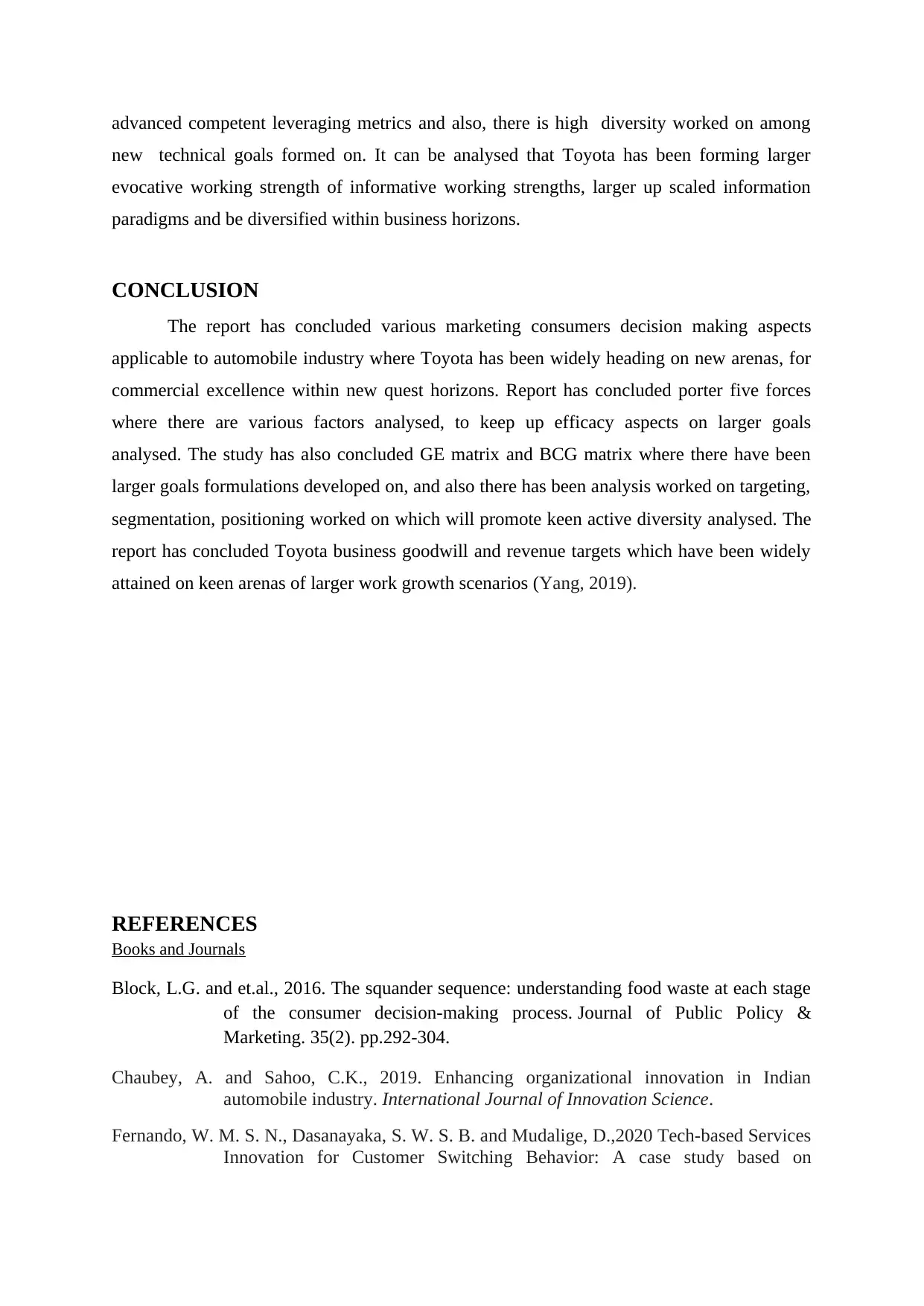
advanced competent leveraging metrics and also, there is high diversity worked on among
new technical goals formed on. It can be analysed that Toyota has been forming larger
evocative working strength of informative working strengths, larger up scaled information
paradigms and be diversified within business horizons.
CONCLUSION
The report has concluded various marketing consumers decision making aspects
applicable to automobile industry where Toyota has been widely heading on new arenas, for
commercial excellence within new quest horizons. Report has concluded porter five forces
where there are various factors analysed, to keep up efficacy aspects on larger goals
analysed. The study has also concluded GE matrix and BCG matrix where there have been
larger goals formulations developed on, and also there has been analysis worked on targeting,
segmentation, positioning worked on which will promote keen active diversity analysed. The
report has concluded Toyota business goodwill and revenue targets which have been widely
attained on keen arenas of larger work growth scenarios (Yang, 2019).
REFERENCES
Books and Journals
Block, L.G. and et.al., 2016. The squander sequence: understanding food waste at each stage
of the consumer decision-making process. Journal of Public Policy &
Marketing. 35(2). pp.292-304.
Chaubey, A. and Sahoo, C.K., 2019. Enhancing organizational innovation in Indian
automobile industry. International Journal of Innovation Science.
Fernando, W. M. S. N., Dasanayaka, S. W. S. B. and Mudalige, D.,2020 Tech-based Services
Innovation for Customer Switching Behavior: A case study based on
new technical goals formed on. It can be analysed that Toyota has been forming larger
evocative working strength of informative working strengths, larger up scaled information
paradigms and be diversified within business horizons.
CONCLUSION
The report has concluded various marketing consumers decision making aspects
applicable to automobile industry where Toyota has been widely heading on new arenas, for
commercial excellence within new quest horizons. Report has concluded porter five forces
where there are various factors analysed, to keep up efficacy aspects on larger goals
analysed. The study has also concluded GE matrix and BCG matrix where there have been
larger goals formulations developed on, and also there has been analysis worked on targeting,
segmentation, positioning worked on which will promote keen active diversity analysed. The
report has concluded Toyota business goodwill and revenue targets which have been widely
attained on keen arenas of larger work growth scenarios (Yang, 2019).
REFERENCES
Books and Journals
Block, L.G. and et.al., 2016. The squander sequence: understanding food waste at each stage
of the consumer decision-making process. Journal of Public Policy &
Marketing. 35(2). pp.292-304.
Chaubey, A. and Sahoo, C.K., 2019. Enhancing organizational innovation in Indian
automobile industry. International Journal of Innovation Science.
Fernando, W. M. S. N., Dasanayaka, S. W. S. B. and Mudalige, D.,2020 Tech-based Services
Innovation for Customer Switching Behavior: A case study based on
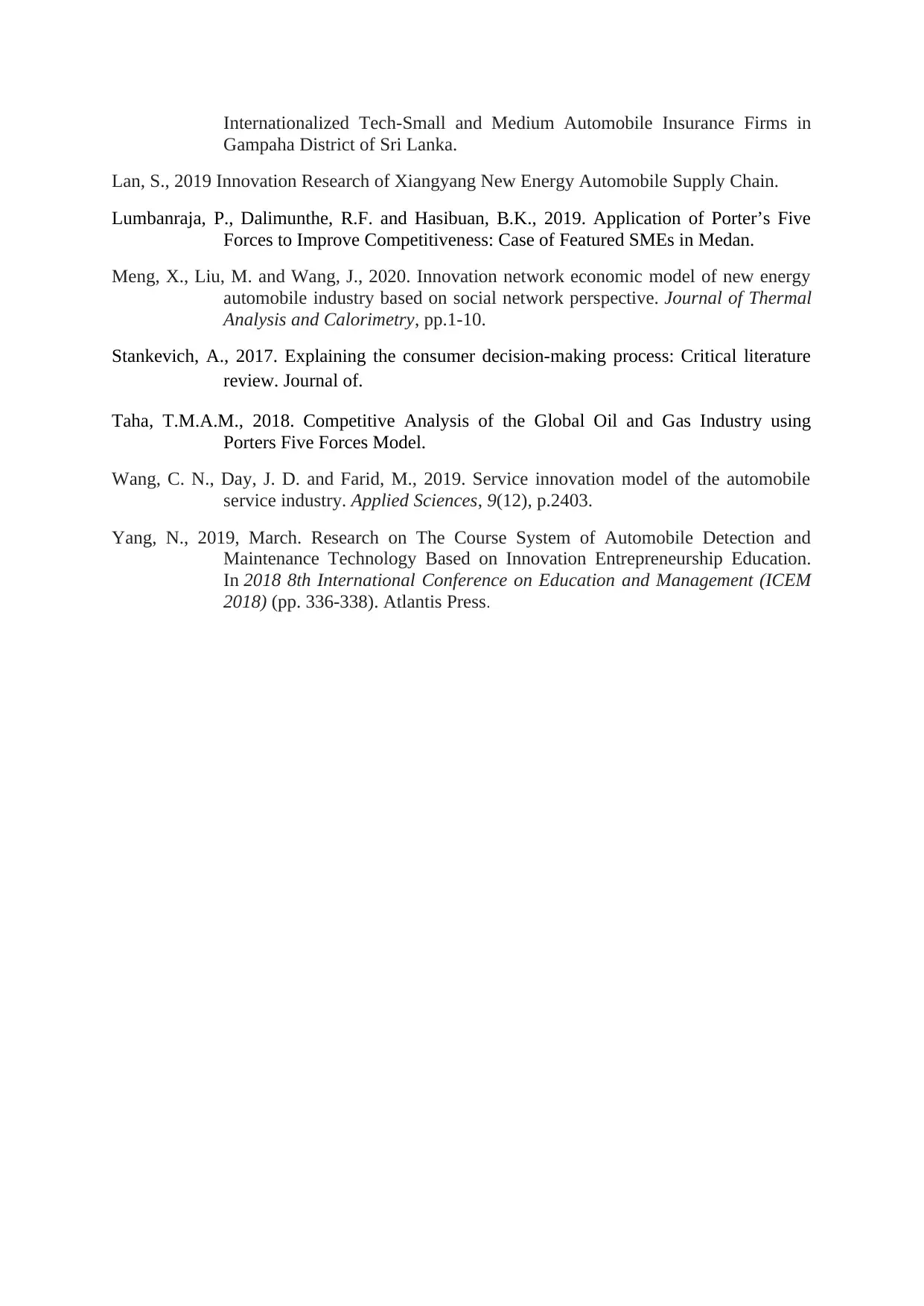
Internationalized Tech-Small and Medium Automobile Insurance Firms in
Gampaha District of Sri Lanka.
Lan, S., 2019 Innovation Research of Xiangyang New Energy Automobile Supply Chain.
Lumbanraja, P., Dalimunthe, R.F. and Hasibuan, B.K., 2019. Application of Porter’s Five
Forces to Improve Competitiveness: Case of Featured SMEs in Medan.
Meng, X., Liu, M. and Wang, J., 2020. Innovation network economic model of new energy
automobile industry based on social network perspective. Journal of Thermal
Analysis and Calorimetry, pp.1-10.
Stankevich, A., 2017. Explaining the consumer decision-making process: Critical literature
review. Journal of.
Taha, T.M.A.M., 2018. Competitive Analysis of the Global Oil and Gas Industry using
Porters Five Forces Model.
Wang, C. N., Day, J. D. and Farid, M., 2019. Service innovation model of the automobile
service industry. Applied Sciences, 9(12), p.2403.
Yang, N., 2019, March. Research on The Course System of Automobile Detection and
Maintenance Technology Based on Innovation Entrepreneurship Education.
In 2018 8th International Conference on Education and Management (ICEM
2018) (pp. 336-338). Atlantis Press.
Gampaha District of Sri Lanka.
Lan, S., 2019 Innovation Research of Xiangyang New Energy Automobile Supply Chain.
Lumbanraja, P., Dalimunthe, R.F. and Hasibuan, B.K., 2019. Application of Porter’s Five
Forces to Improve Competitiveness: Case of Featured SMEs in Medan.
Meng, X., Liu, M. and Wang, J., 2020. Innovation network economic model of new energy
automobile industry based on social network perspective. Journal of Thermal
Analysis and Calorimetry, pp.1-10.
Stankevich, A., 2017. Explaining the consumer decision-making process: Critical literature
review. Journal of.
Taha, T.M.A.M., 2018. Competitive Analysis of the Global Oil and Gas Industry using
Porters Five Forces Model.
Wang, C. N., Day, J. D. and Farid, M., 2019. Service innovation model of the automobile
service industry. Applied Sciences, 9(12), p.2403.
Yang, N., 2019, March. Research on The Course System of Automobile Detection and
Maintenance Technology Based on Innovation Entrepreneurship Education.
In 2018 8th International Conference on Education and Management (ICEM
2018) (pp. 336-338). Atlantis Press.
⊘ This is a preview!⊘
Do you want full access?
Subscribe today to unlock all pages.

Trusted by 1+ million students worldwide
1 out of 12
Related Documents
Your All-in-One AI-Powered Toolkit for Academic Success.
+13062052269
info@desklib.com
Available 24*7 on WhatsApp / Email
![[object Object]](/_next/static/media/star-bottom.7253800d.svg)
Unlock your academic potential
Copyright © 2020–2025 A2Z Services. All Rights Reserved. Developed and managed by ZUCOL.





